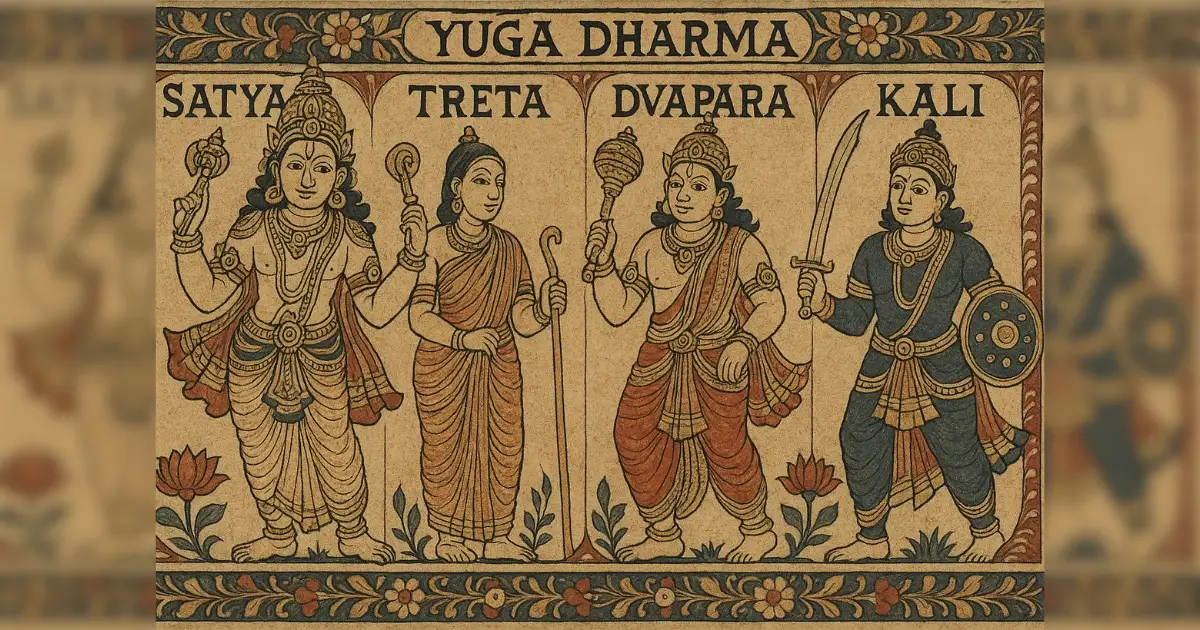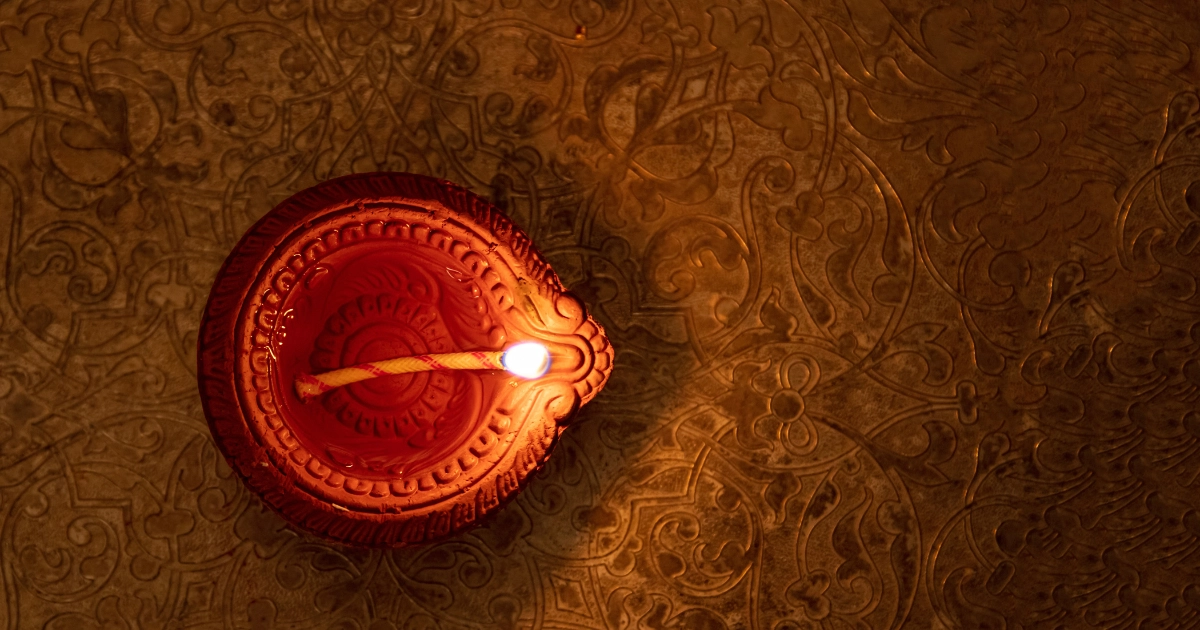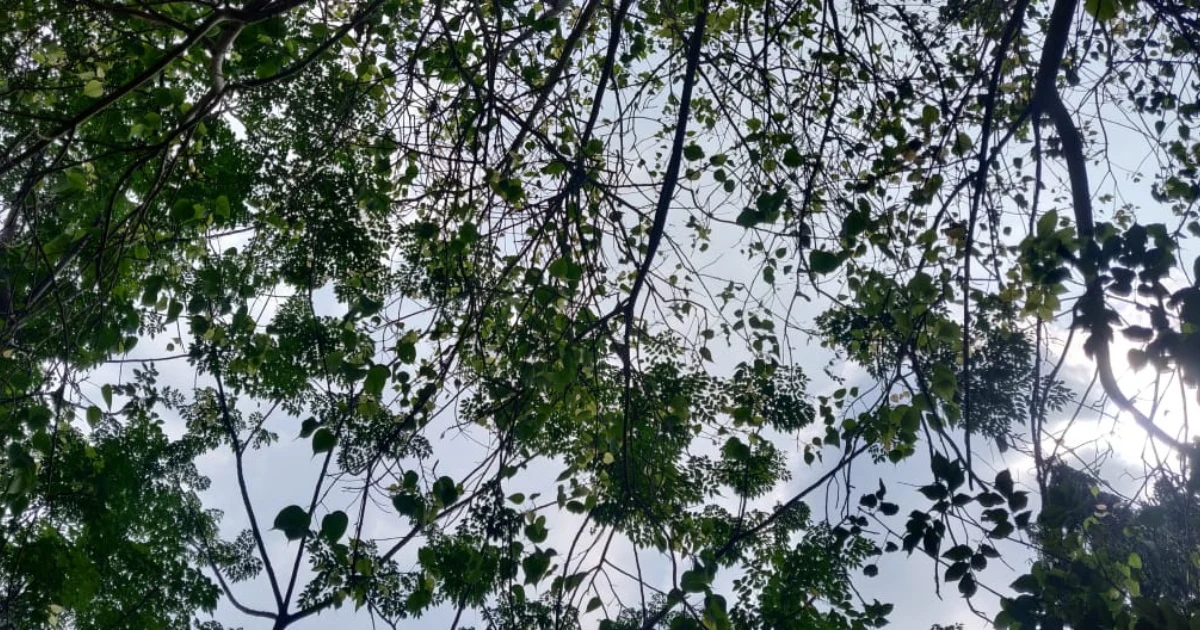Introduction: A Framework for Understanding Human Decline and Renewal
In an era marked by declining lifespans in developed nations, rising chronic diseases, and widespread spiritual disconnection, the ancient Hindu concept of Yuga Dharma offers a profound lens for understanding these contemporary challenges. Far from being mere mythology, the systematic study of cosmic cycles (yugas) presented in texts like the Manusmṛti, Parāśarasmṛti, and Mahābhārata provide a sophisticated framework that correlates cosmic harmony with human physical capacity, moral development, and spiritual potential.
This traditional knowledge suggests that what we perceive as modern problems - shortened attention spans, increased dependence on external stimuli, and the need for immediate gratification - may actually be predictable manifestations of our current position in cosmic time. Understanding Yuga Dharma offers both historical perspective and practical guidance for navigating our present age.
The Cosmic Clock: Understanding Deep Time and Human Cycles
Divine Time Measurement
The foundation of Yuga Dharma rests on a sophisticated understanding of cosmic time. According to Manu (1.37):
deve rātryahanī varṣaṃ pravibhāgastayor punaḥ |
ahastatrodagayanaṃ rātriḥ syāddakṣiṇāyanam ||
Manu 1.37For the gods, a year is like a full day: Uttarāyaṇa (the sun's northward journey) is their daytime, Dakṣiṇāyana (the sun's southward journey) is their night. So one human year equals one day and night for the gods.
This astronomical precision - linking cosmic cycles to the Earth's orbital mechanics with the understanding that 1 divine year is equal to 360 human years - suggests that ancient sages understood time scales that modern science has only recently begun to appreciate. Just as we now recognize geological epochs and evolutionary time scales, the yuga system presents human development within vast cosmic rhythms spanning millions of years.
The Mathematical Structure of Cosmic Ages
The systematic nature of these cycles is detailed in Manu (1.69):
catvāryāhuḥ sahasrāṇi varṣāṇāṃ tatkṛtaṃ yugam |
tasya tāvachatī saṃdhyā saṃdhyāṃśaśca tathāvidhaḥ ||
Manu 1.69The Kṛta Yuga (the first age) is said to last 4,000 divine years. In addition to this, there is a 'Sandhyā' (dawn period) and a 'Sandhyāṁśa' (dusk period) - each lasting 400 divine years. So the total span of the Kṛta Yuga is 4,800 divine years.
This mathematical precision reveals a sophisticated understanding of transitional periods. The saṃdhyā represents the yugārambha (beginning phase), and saṃdhyāṃśa the yugāvasāna (ending phase), totaling 4,800 divine years or 1,728,000 human years for Kṛta Yuga alone. This parallels how modern systems theory recognizes that major changes occur not abruptly, but through transitional phases, suggesting an understanding that civilizational changes happen gradually.
The pattern of systematic decline is outlined in Manu (1.70):
itareṣu sasaṃdhyeṣu sasaṃdhyāṃśeṣu ca triṣu |
ekāpāyena varttante sahasrāṇi śatāni ca ||
Manu 1.70
This one decrease each (ekāpāyena) principle creates a precise mathematical structure: Kṛta Yuga (4,800 divine years/1,728,000 human years), Tretā Yuga (3,600 divine years/1,296,000 human years), Dvāpara Yuga (2,400 divine years/864,000 human years), and Kali Yuga (1,200 divine years/432,000 human years). The complete Mahāyuga (Caturyuga) spans 12,000 divine years or 4,320,000 human years.
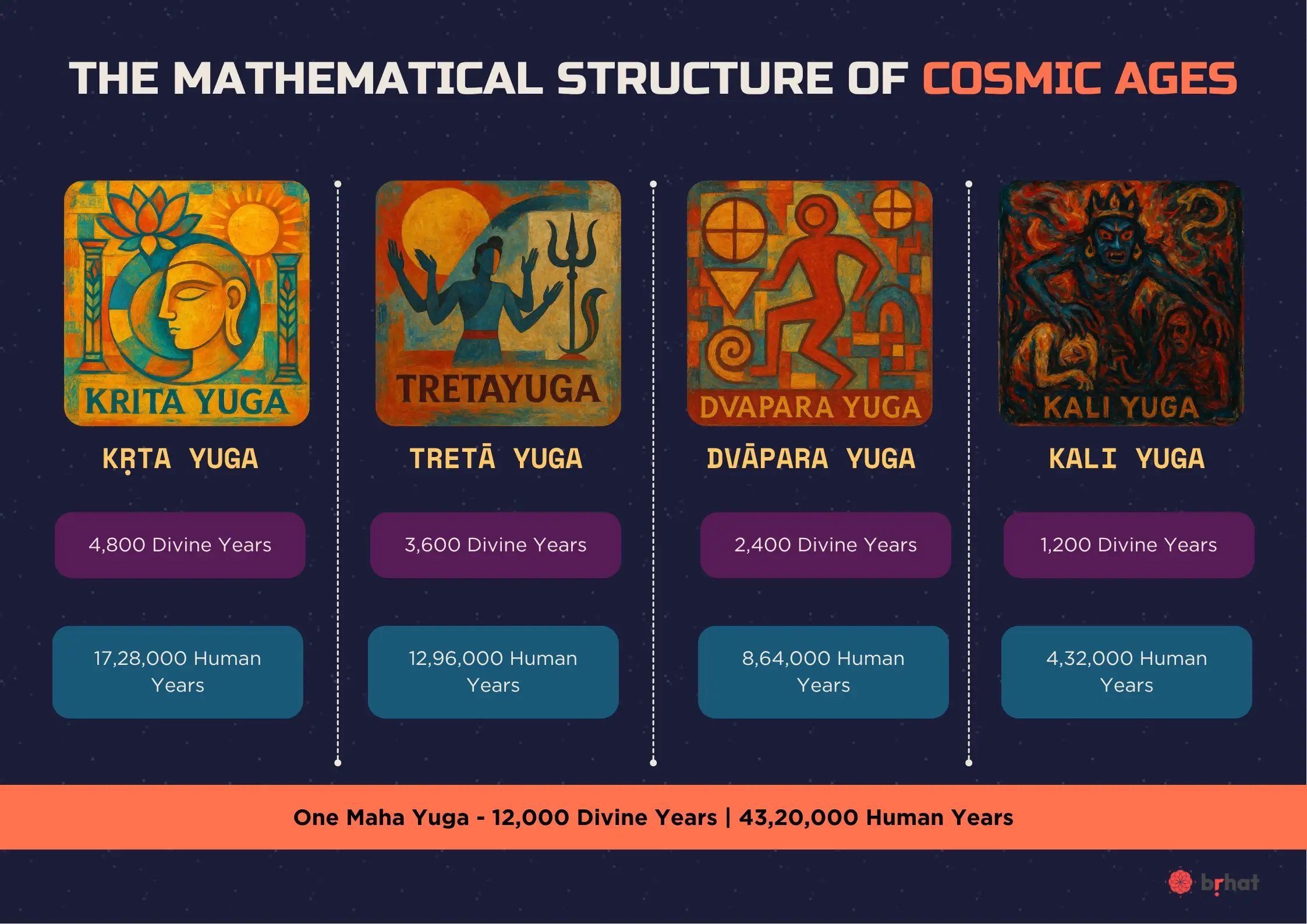
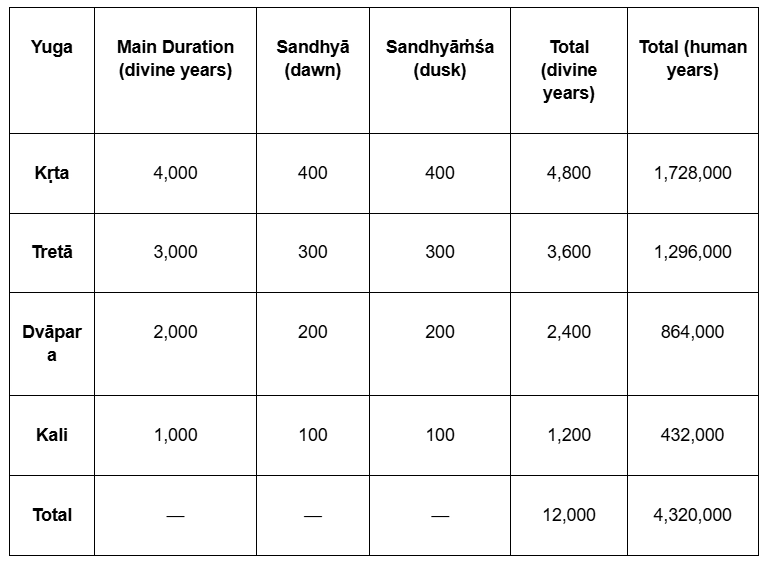
This accelerating rate of change - with each yuga being progressively shorter - remarkably parallels how technological and social change has accelerated in recent centuries, with each generation experiencing more rapid transformation than the previous one.
The Longevity Paradox: Ancient Health Spans vs. Modern Medicine
The Traditional Model of Human Lifespan
Perhaps the most challenging aspect of Yuga Dharma for modern readers is its claim about extended human lifespans in earlier ages. Manu (1.83) states:
arogāḥ sarvasiddhārthāścaturvarṣaśatāyuṣaḥ |
kṛte tretādiṣu tveṣāṃ vayo hrasati pādaśaḥ ||
Manu 1.83In the Kṛta Yuga, people were healthy (arogāḥ), fulfilled in all goals (sarvasiddhārthāḥ), and lived for 400 years. However, in subsequent Yuga - Tretā, Dvāpara, and Kali - these qualities decline progressively by one-quarter (pādaśaḥ).
This systematic reduction creates a precise lifespan structure: Kṛta Yuga (400 years), Tretā Yuga (300 years), Dvāpara Yuga (200 years), and Kali Yuga (100 years or less). The progression indicates not just longer lifespans but complete freedom from disease and the ability to accomplish all desires, suggesting a qualitatively different mode of existence entirely.
This presents a fascinating paradox: while modern medicine has extended average lifespans, we simultaneously face epidemics of chronic disease, mental health issues, and what might be called existential poverty - the inability to accomplish our deeper desires despite material abundance.
Historical Evidence and Contemporary Relevance
The Rāmāyaṇa provides specific historical claims:
daśavarṣasahasrāṇi daśavarṣaśatāni ca |
rāmo rājyamupāsitvā brahmalokam prayāsyati ||
Rāmāyaṇa 1.1.97Rāma, having ruled the kingdom for ten thousand years and ten hundred years, will proceed to Brahmaloka.
The traditional understanding acknowledges that such extraordinarily long lifespans in Itihāsas and Purāṇas are achieved through intense tapas (austerity) and śraddhā (devotion/faith), representing idealized or symbolic achievements rather than standard biological expectations. However, they point to possibilities that transcend ordinary human limitations.
While such lifespans seem impossible by current standards, they become more meaningful when understood as representing different qualities of life. The Mahābhārata offers a key insight:
yāvatyāvadbhūcchraddhā dehaṃ dhārayituṃ nṛṇām |
tāvattāvadajīvaṃste nāsīdyamakṛtaṃ bhayam ||As long as people had firm faith (śraddhā) to sustain their bodies, they lived accordingly, without fear of Yama (death due to natural causes).
This reveals that longevity was directly connected to spiritual strength and inner conviction, with consciousness itself playing a determining role in physical durability.
The Decline Principle: Understanding Contemporary Challenges
Diminishing Returns Across All Domains
Manu (1.84) presents a comprehensive theory of decline that extends beyond mere lifespan:
vedoktamāyurmarttyānāmāśiṣaścaiva karmaṇām |
bhavatyānugayaṃ loke prabhāvāśca śarīriṇām ||
Manu 1.84The lifespan prescribed in the Vedas for mortals, the results of actions (āśiṣaḥ), and the powers of embodied beings (prabhāvāśca) manifest in the world according to each yuga.
This principle suggests that not only physical capacity, but also the effectiveness of human actions, and even access to subtle capabilities, diminishes over cosmic time. Contemporary parallels might include:
- Diminishing attention spans: The average human attention span has reportedly decreased from 12 seconds in 2000 to 8 seconds today.
- Reduced efficacy of actions: The increasing complexity required to achieve results in modern systems.
- Loss of intuitive capabilities: The documented decline in children's ability for unstructured play and creative problem-solving.
Adaptive Dharma: Spiritual Practices for Different Ages
The genius of Yuga Dharma lies in its adaptive prescriptions. Manu (1.86) outlines age-appropriate spiritual practices:
tapaḥ paraṃ kṛtayuge tretāyāṃ jñānamucyate |
dvāpare yajñamevāhurdānameva kalau yuge ||
Manu 1.86Tapas (austerity) is supreme in Kṛta Yuga, in Tretā jñāna (knowledge) is declared supreme, in Dvāpara yajña (sacrifice) is proclaimed, and in Kali Yuga, dāna (charity) alone.
This progression from individual austerity → knowledge → ritual community action → compassionate service reflects a decreasing capacity for internal discipline but an increasing need for external support and community engagement. Modern mindfulness movements, with their emphasis on accessible meditation techniques rather than extreme austerities, seem to align with this Kali Yuga prescription.
Social Evolution and Moral Frameworks
The Changing Nature of Human Interaction
Parāśarasmṛti provides detailed observations about how human sensitivity and social contamination change across ages:
kṛte saṃbhāṣaṇādeva tretāyāṃ sparśanena ca |
dvāpare tvannamādāya kalau patati karmaṇā ||
Parāśara 2.23In Kṛta, one becomes fallen merely by conversation (with the fallen), in Tretā by touch, in Dvāpara by accepting food, and in Kali by action.
This progression from high sensitivity (conversation) to reduced sensitivity (requiring physical action) parallels modern observations about decreased empathy and the need for more explicit ethical guidelines in contemporary society. Where once subtle social cues sufficed, we now require detailed codes of conduct and legal frameworks.
Changing Consequences and Response Times
The temporal aspect of moral consequences also shifts over the progression of cosmic time:
kṛte tatkṣaṇataḥ śāpastretāyāṃ daśabhirdinaiḥ |
dvāpare tvekamāsena kalau saṃvatsareṇa tu ||
Parāśara 2.27In Kṛta, the curse takes effect immediately, in Tretā after ten days, in Dvāpara after one month, and in Kali after one year.
This delayed feedback mechanism in Kali Yuga may explain why modern society struggles with long-term consequences of actions - from climate change to public health crises. The traditional framework suggests this is a predictable feature of our current age, requiring different approaches to moral education and social organization.
The Physiology of Consciousness: Understanding Human Vitality
The Migration of Life Force
Perhaps the most sophisticated aspect of Yuga Dharma is its physiological framework. Parāśarasmṛti (3.32) describes the progressive decline in human longevity across the cosmic ages through the metaphor of life force location:
kṛte tvasthigatāḥ prāṇāstretāyāṃ māṃsamāśritāḥ |
dvāpare rudhiraṃ caiva kalau tvannadiṣu sthitāḥ ||
Parāśara 3.32In Kṛta, people lived until the life force (prāṇa) reached the bones, in Tretā until it reached the flesh, in Dvāpara until it reached the blood, and in Kali it resides merely in food and other external substances.
This verse describes the progressive shortening of human lifespan across the yugas. In the Kṛta Yuga, people lived so long that their bodies endured until the very core - the bones - were affected by age. In Tretā, lifespans shortened such that people died when aging reached the muscular flesh. By Dvāpara, lives became shorter still, ending when the blood was affected. In our current Kali Yuga, human vitality is so diminished that it depends entirely on external sustenance like food, making life both brief and fragile.
This progression from the deepest structural level (bones) to complete external dependency (food) suggests an understanding that human longevity has dramatically decreased across the cosmic ages. The verse describes not just where life force resides, but how deeply into the body's structure aging must penetrate before death occurs. Contemporary parallels to this shortened lifespan include:
- Reduced structural resilience: Modern humans experience bone density decline and joint problems much earlier in life compared to traditional accounts of exceptional longevity.
- Diminished muscular endurance: The need for constant exercise regimens to maintain basic physical capacity, unlike the natural strength attributed to earlier ages.
- Cardiovascular fragility: Increased dependence on medical interventions and stimulants to maintain circulation, reflecting the blood-level vulnerability described for Dvāpara.
- External life support: The modern reliance on frequent meals, supplements, and external aids for basic vitality, embodying the Kali Yuga condition where life force depends entirely on food and external substances rather than internal constitutional strength.
This framework suggests that what we consider normal human limitations today - short lifespans, frequent need for food, vulnerability to disease - are actually symptoms of our current cosmic age rather than inherent human nature.
Contemporary Applications: Living Consciously in Kali Yuga
Practical Adaptations for Modern Life
Understanding our position in Kali Yuga offers practical guidance for contemporary living:
Energy Management: Since life force is externally dependent, conscious attention to nutrition, sleep, and environmental factors becomes crucial - explaining the modern rise of wellness culture and biohacking.
Community Building: The emphasis on dāna (charity) and service in Kali Yuga suggests that individual spiritual practices must be balanced with community engagement and social contribution.
Realistic Expectations: Rather than trying to replicate austere practices from earlier ages, focusing on accessible techniques appropriate to current human capacity.
Karmic Timing and Modern Decision-Making
The year-long delay in karmic consequences characteristic of Kali Yuga has profound implications for modern decision-making and social policy. Unlike earlier ages where immediate feedback guided behavior, our current age requires:
- Long-term thinking: Developing systems that account for delayed consequences
- Institutional memory: Creating structures that maintain awareness of cause-and-effect relationships across extended time periods
- Predictive frameworks: Using scientific modeling and traditional wisdom to anticipate outcomes
- Patient persistence: Understanding that positive changes may take extended time to manifest
This framework helps explain why modern challenges like environmental degradation, social inequality, and public health crises require sustained, long-term approaches rather than expecting immediate results.
Summary of Key Concepts
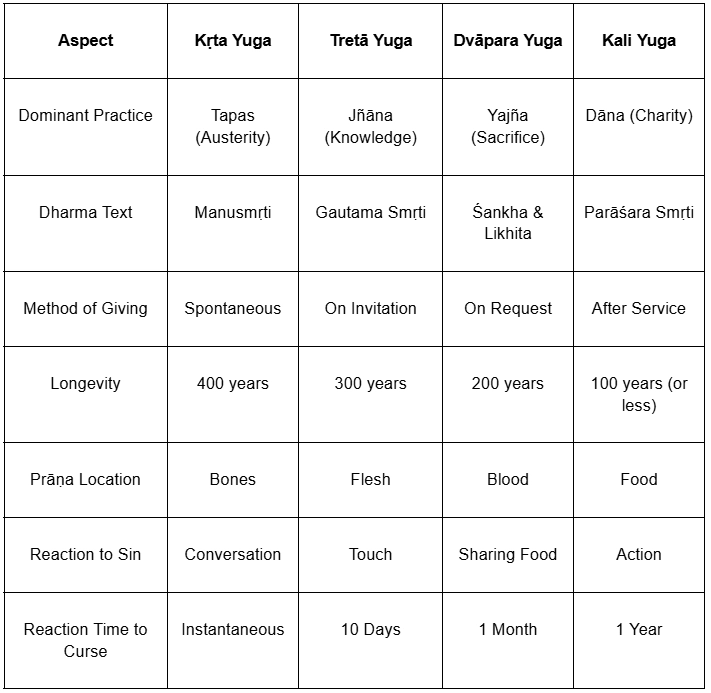
Future Implications: Renewal and Cyclical Hope
The Promise of Cyclical Time
Unlike linear models of progress or decline, the yuga system is ultimately cyclical. After Kali Yuga reaches its nadir, the cycle begins anew with another Kṛta Yuga. This provides hope that current challenges are temporary phases rather than permanent deterioration.
Seeds of Renewal in the Present Age
Even within Kali Yuga, the tradition speaks of sub-cycles and the possibility of individual transcendence. The very preservation and study of these texts suggests that knowledge of higher possibilities remains available for those who seek it.
Conclusion: Ancient Wisdom for Modern Challenges
The doctrine of Yuga Dharma offers more than historical curiosity - it provides a framework for understanding contemporary human challenges as predictable features of cosmic cycles rather than unprecedented crises. This perspective encourages both acceptance of current limitations and continued effort toward individual and collective transformation.
Rather than viewing shortened lifespans, decreased attention, and increased dependence on external supports as failures of modern civilization, the yuga framework suggests these are natural features of our current cosmic position. The key insight is adaptation: the ability to work skillfully with current capacities, rather than lamenting their limitations.
The sophisticated integration of astronomy, physiology, psychology, and spirituality in these ancient texts points toward a holistic understanding of human potential that transcends the artificial divisions of modern specialized knowledge. As we face unprecedented global challenges, this integrative wisdom tradition offers both perspective and practical guidance for navigating our complex present while maintaining connection to humanity's deeper possibilities.
The precision with which these texts describe the mathematical relationships between cosmic time and human capacity, combined with their practical relevance to contemporary challenges, suggests that serious engagement with traditional wisdom may be essential for addressing the crises of our time. In recognizing where we are in the cosmic cycle, we can work more effectively with the opportunities and constraints of our particular age.
Reference
- Dīkṣita, V. (1937). Smṛtimuktāphalaṃ (J. Raghunāth Ghārapure, Ed.) [Sanskrit]. Āryabhūṣaṇ Press.
